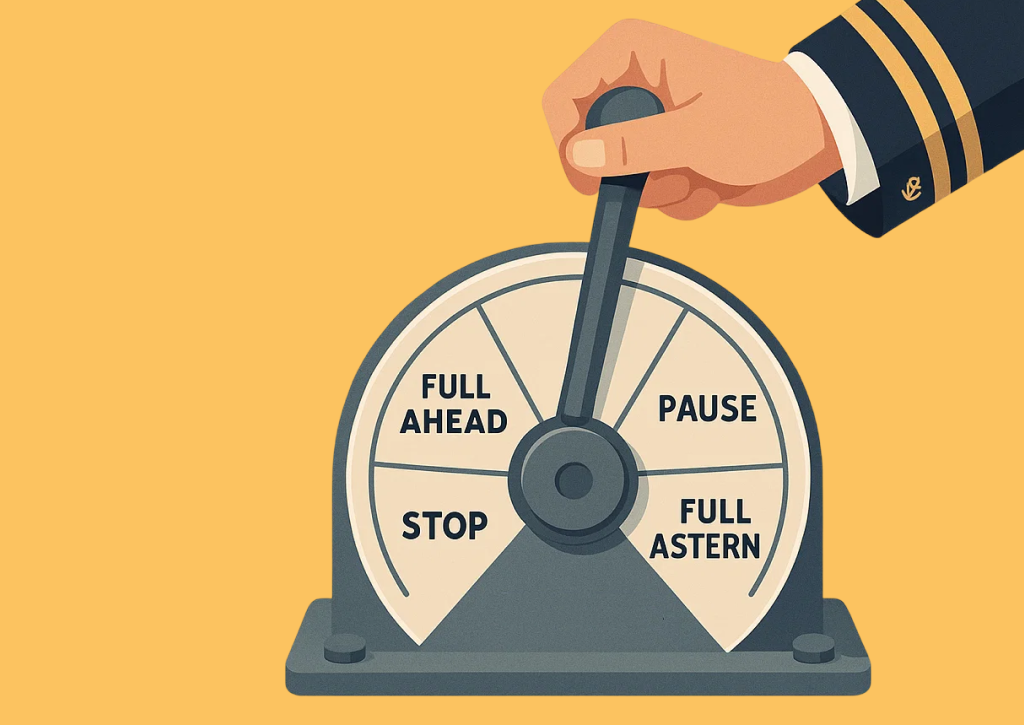Software development is expensive — and rightly so. Skilled engineers, modern tools, and cloud infrastructure all come at a price. For any client watching their monthly invoice, that cost feels tangible. Naturally, they want to stay in control: to know exactly what the team is building and why. There’s nothing more frustrating than seeing a large invoice arrive after a period when “nothing seemed to happen.”
This is where a common temptation appears — to take a short break, freeze the project, and stop the expenses while rethinking priorities. On paper, it sounds reasonable. In reality, it triggers a chain reaction that harms both sides.
At a Glance

From the client’s perspective, a pause feels like financial discipline. From the team’s perspective, it feels like the project is sinking. The momentum breaks, people disperse, and what was once a living, breathing product becomes a stalled initiative.
Every software project is like a ship already at sea.
But once someone says, “let’s stop for a week,” the ship starts drifting backwards. Energy leaks away, deadlines blur, and restarting becomes far costlier than continuing.
Developers Are a Rare Resource That Should Never Sit Idle
A skilled developer is not a machine you can simply switch off and back on again. The industry faces a chronic shortage of qualified engineers, and leaving them idle is not only expensive but demotivating. Even a short pause can prompt people to look for something more stable. Staff turnover caused by uncertainty often costs more than the pause itself. When an experienced developer leaves, they either return with higher expectations or don’t return at all.
People Can’t Be Reassigned Instantly
In professional teams, developers are rarely moved between projects in less than a month. That’s not bureaucracy — it’s a safeguard against burnout and loss of focus. Constant switching between projects forces the brain into a state of context fragmentation. Research shows that every such switch reduces productivity by 15–25 per cent. It takes time to understand an architecture, recall the project’s history, and reach a flow state. If a project is paused, the team doesn’t just wait around — they get reallocated elsewhere. And once that happens, you’ve effectively split your team in two.
The Restart Costs More Than the Pause
A week-long break rarely means a week-long recovery. When the project resumes, the team has to restore the development environment, restart CI/CD pipelines, recall priorities, and resynchronise. Documentation goes stale during downtime — nobody notices until it’s too late. The result:
And that’s before you count the defects that creep in due to loss of focus.
Holding Costs Are Real
Keeping a team “on hold” is a luxury few companies can afford. Idle time is not billable to the client, but salaries still need to be paid. A five-person team paused for a week can cost tens of thousands of pounds in wasted payroll. But that’s just the visible part. Licences, cloud services, and CI/CD pipelines continue to consume resources. You can technically shut down a cloud environment for a month — but in practice, that’s often forgotten. Those are sunk costs that will never be recovered.
Teams Can’t Work on Two Fronts
Developers can’t meaningfully run two projects in parallel without quality suffering. When one project pauses, another quickly takes its place. A developer who was immersed in Project A — its architecture, quirks, and backlog — suddenly has to jump into Project B, which works differently. The human brain can’t maintain two deep technical contexts at once. One inevitably overwrites the other.
Knowledge Evaporates Faster Than Code
The code stays in the repository, but the knowledge around it has a short shelf life. Many architectural choices are never written down because they felt obvious at the time. After a few months’ break, developers return to a detective mission: why was this framework chosen? Why is this pattern used here? If even one team member has left — as often happens — newcomers struggle to reconstruct the logic. They duplicate functions, repeat past mistakes, and lose time rediscovering old decisions.
You Might Not Get the Same Team Back
When a project restarts, you rarely get the same team you paused with. Some people are reassigned to critical projects, others take new contracts, and some simply decide they prefer stability. New engineers take time to get up to speed, but the real loss is less visible — the cohesion, trust, and flow that the old team had. Rebuilding that chemistry takes months, not days.
Fixed Costs Don’t Pause With You
A pause is often mistaken for saving money. In reality, your fixed costs continue ticking. Cloud platforms, software licences, monitoring tools — all keep running. The project may be frozen, but AWS still sends a full invoice. A month-long pause can quietly drain the budget without a single line of code being written.
Momentum Is the Cheapest Resource — and It Vanishes Quickly
When a team is in motion, everything runs smoothly. People know what to do, they’re synchronised, and they’re motivated. This momentum is your cheapest asset — and the easiest to lose. Even a two-week pause destroys it completely. Restarting means rebuilding focus, rewriting plans, and reigniting motivation. It’s far more costly than maintaining steady progress.
You Risk Losing the Client
When a client’s project goes on hold, competitors don’t wait. The client starts to wonder: does the contractor really know what they’re doing? Is there a hidden risk? If the pause wasn’t planned and formalised, trust erodes quickly. Even if the project later finishes successfully, the relationship suffers. The next contract might never happen.
The Real Cost of Stopping
A pause may feel like a smart financial decision, but in reality, it’s a turn against the wind.
Projects shouldn’t be stopped completely — only slowed down. Reduce speed if you must, but keep moving. Because a ship that stalls rarely returns to the same point.
And when in doubt, talk to your development partner before pulling the brakes. Together, you can find a smarter way to optimise cost without losing direction — and that’s where the real savings are found.


